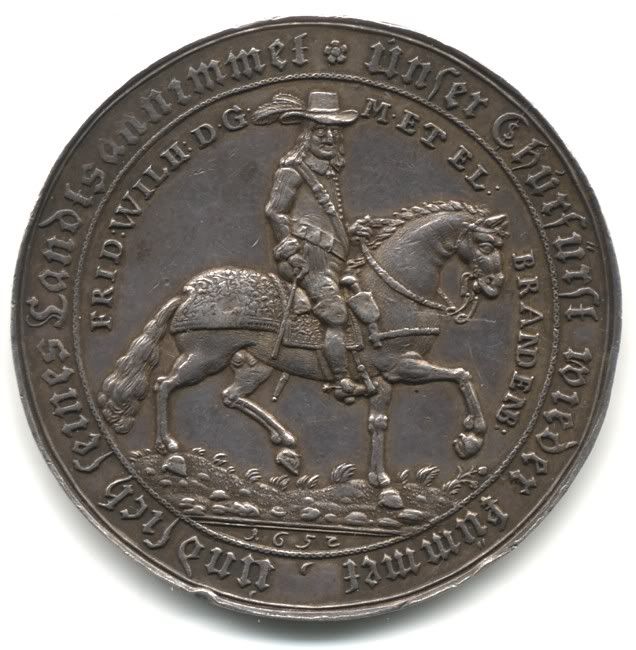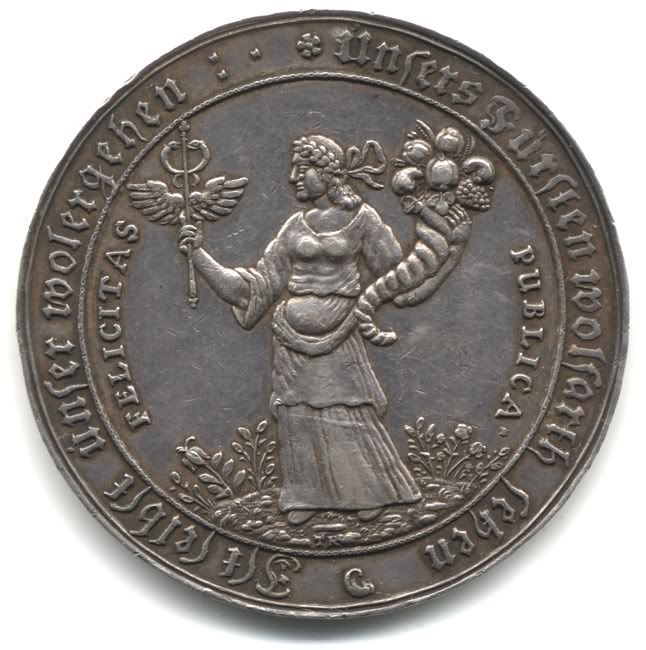Options
1652 Brandenburg medal
Took a bunch of NPs to the bank the other day and as I was sorting them into their appros boxes, I came across a medal/schautaler that I've owned a long time.
The piece originated from a small but spectacular group purchased in the early 1980s (showing my age, alas!) by Bill Armstrong, known as “the foreign coin dealer” in St Louis for years and years. Included was a 4 taler Brunswick flying horse and several double talers as well as a nice 1590 Piacenza piastra (which I own).
At any it’s an issue of Friedrich Wilhelm of 1652, just over 56mm and a weight of 54.3gms. It was sold as a double, but its not in Davenport, etc and an old Schulman catalogue (which now resides somewhere in my basement) indicated a similar piece was a schautaler. This seems to be in a German dialect, but my very rough translation/guess of the obverse is “Our Elector again comes along with his council” but I’ve not been able to tie down the reverse.
Can anyone provide me with a more exact translation and identify the occasion for which this was issued? Thanks!



The piece originated from a small but spectacular group purchased in the early 1980s (showing my age, alas!) by Bill Armstrong, known as “the foreign coin dealer” in St Louis for years and years. Included was a 4 taler Brunswick flying horse and several double talers as well as a nice 1590 Piacenza piastra (which I own).
At any it’s an issue of Friedrich Wilhelm of 1652, just over 56mm and a weight of 54.3gms. It was sold as a double, but its not in Davenport, etc and an old Schulman catalogue (which now resides somewhere in my basement) indicated a similar piece was a schautaler. This seems to be in a German dialect, but my very rough translation/guess of the obverse is “Our Elector again comes along with his council” but I’ve not been able to tie down the reverse.
Can anyone provide me with a more exact translation and identify the occasion for which this was issued? Thanks!



Always interested in St Louis MO & IL metro area and Evansville IN national bank notes and Vatican/papal states coins and medals!
0
Comments
Taler Custom Set
Ancient Custom Set
World Collection
British Collection
German States Collection
It is a medal by T. Ruess and struck upon the Duke's return from Prague. It says something about his return to take care of his country and its fortune. It also mentions that he is a elector of the HRE.
3Mark
I'm new here, but I belong to several other boards dealing with coins. Pre-1806 HRE coins are all I really care about, and I think this medal is just plain beautiful.
I believe it was minted in a not-so-poetic time, however. As a preface, I got into Pre-1806 HRE coins based on my interest in the history of the era. That being said, in 1652, not many people would have given Friedrich Wilhelm the "Great Elector" epithet. Brandenburg was beginning to climb out of the complete and total destruction of the 30YW (my abbrev. for Thirty Years War), and as the electorate perhaps most hard-hit by the passive and active destruction of that war, it wouldn't recover for essentially another hundred years. Friedrich Wilhelm had lost a (seemingly) more valuable territory, and had gained a pittance -- the rights to secularized Lutheran bishoprics which were merely land-bridges for territory, and the burned-out husk of Magdeburg.
Additionally, he'd just fought the so-called "Cow War" with the Duke of Pfalz-Neuburg, which he'd lost ignobly. He was still shy of his later stunning success (and also failures) in the Northern War, and he was vulnerable to an extreme.
In 1652, the electors were called for a series of informal "meetings" in Prague with Ferdinand III, where Ferdinand sought to arrange for the exchange of favors to secure his son, Ferdinand IV, as King of the Romans (ie: Heir Presumptive of the HRE). In exchange, Ferdinand promised Brandenburg that he would apply pressure to the Swedes to give back certain Pommeranian territory to the Elector, and also resolve a dispute over Baltic tariffs in favor of the Elector. This meeting, though talked about, wasn't very special. At the end of that meeting, the Electors traveled to Regensburg for the "official" vote and coronation of Ferdinand IV as KoR. The Reichstag then assembled as of October 1, 1652, and began its debates.
THIS meeting was very significant, because it was the formal adoption and ratification of the terms of the (temporary) Peace of Westfalen, drafted in 1648. Without this session and the Reichstag's consideration of the Peace terms, it is entirely possible (in the minds of those present) that religious conflict could continue (though the capacity of any state in the HRE to continue warfare is severely in doubt).
This medal, then, I don't think was necessarily about the trip to or return from Prague, but more perhaps about the (long-lasting) trip to and from Prague AND Regensburg for the conclusion of the Peace. I don't have my materials with me either, and my archaic High German is rusty (I took a class as a German major in college), but it is my belief the legend says the following (and I have included modern german words next to particularly archaic ones):
Obverse Legend: "Unser Churfuerst [Kurfuerst] wieder Kuemmet [see below], und sich seines Landts [Landes] annimmet [annimmt]"
My Translation: Our Elector "rides off" again, and ministers to his Domains.
Reverse Legend: "Unsers Fuersten wolfarth [Wohlfahrt] sehen ist selbst unser wolergehen [Wohlergehen]"
My Translation: "Seeing to the welfare of our Prince / is in itself our well-being"
I translate "Kuemmet" (ue = umlauted u) as to "ride off" or "saddle up" (as they might say in a western), because by 1652, "kommen" was written in some dialects just like it is today, and in others it was written as "kummen". There is another phrase in modern German, however -- Kummet -- which refers to the bits and bridle of a horse. The phrase is eastern German and Slavic in origin, and was popularly used beginning in the 15th century. I believe, then, that "he comes" would have been written as "[er] kummt" or "kommt", while this is a more specific word. Therefore, the best connection I can think of is "saddling up" or "bridling the horses".
I also translated "sich....annimmet" as the reflexive verb "sich annehmen", because the archaic form of the third person singular is one letter off from "sich...annimmt", which is the modern third person singular. Annehmen when used in a reflexive way means something closer to "to see after", "to administer", or "to minister to" (which is in itself an anglicized form of Latin "ad ministrare", similarly reflexive).
Lastly, Wohlfahrt and Wohlergehen are both forms of the word "welfare", but Wohlergehen has a more "universal" connotation, that I think applies here.
Hope this helps; if anyone disagrees with my translation, I'd love to engage in a good dialogue about it! Something you may find out while I'm on this board is that I have a real passion for these coins, and the language on them!
--tewcd
Feel free to ask for my BST references!
*I reserve the right to change the direction of my collection at whiplash-inducing speeds.
Feel free to ask for my BST references!
*I reserve the right to change the direction of my collection at whiplash-inducing speeds.
And, welcome to the board Tewcd, you're already an asset to the group!
I've always found the image of FW somewhat less than heroic, certainly he could stand to lose a few pounds.
Altho I pretty much blundered the translations, I did recognize that the legends in script on both sides are rhymes which I find kinda nifty. What really attracted me to this piece, however, was the reverese which basically lifts wholesale a stock roman type complete with a caduceus and cornucopia symbolic of peace and plenty and the latin legend Happiness of the People. Ties nicely to the ratification of the Peace of Westfalen however temporary it might have been.
I think I've owned this piece for close to 30 years, and now, thanks to the help I received here, finally appreciate its significance. A great reminder of not only the value of so many knowledgable contributors willing to freely share their knowledge but also why I bother to collect at all.
I'm a happy bunny!